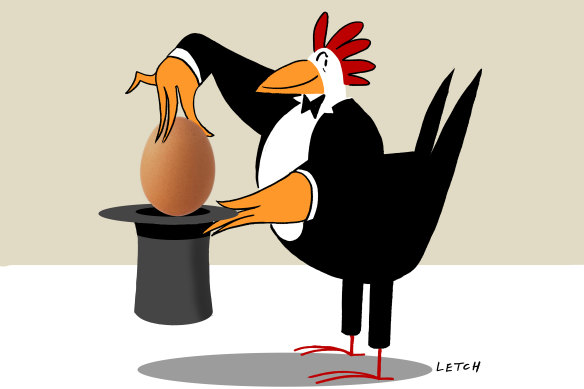Opinion
Have you heard of retirement bonuses? Here’s how to get one
Bec Wilson
Money contributorDo you want a retirement bonus?
About 40 per cent of Aussie super funds are handing out cash bonuses at retirement, aiming to “do what’s right” for their members. The average retirement bonus in Australia is between $2000 and $5000. Some funds point to payments of as high as $22,800 this year.

A bonus on top of your super when you retire is a feature many funds are using to attract new members.Credit: Simon Letch
However, not all funds are offering these bonuses, and of those that do, each handle it differently. Some might even be using them as a flashy marketing tactic, so it’s important to understand them properly.
This week, I spoke with a few funds to dive deep into the different ways they are promoting, calculating and providing retirement bonuses. I’m breaking them open to make them a little easier to understand.
When you enter the retirement phase of superannuation, you move from paying 15 per cent tax on the income your super generates in the accumulation phase, discounted capital gains tax on growth, to paying no tax at all.
None! Zip! Zero! Zilch! No income tax, no CGT on assets held over the long or short term. Bear in mind, this tax-free status applies only to the amount transferred to the retirement phase, under the $1.9 million transfer balance cap.
Don’t be swayed solely by flashy advertising - consider the bigger picture.
Super funds invested in assets in the accumulation phase set aside money to pay these taxes in a process called provisioning. This can build up quite a healthy amount in a strong performance year.
But when you move from the accumulation to the retirement phase, that tax is no longer required to be paid. So the fund can either absorb the provisioned amounts back into the pool for all members or pay it back to you as a lump sum or bonus when you retire.
About 40 per cent of funds are choosing to pay it back to members, while others absorb the provisioning back into their pooled funds. I expect the bonus will become more common as the competitive market for retirement phase offerings heats up as many people review and compare their super funds pre-retirement.
Many of the funds that are choosing to pay it back to you as a lump sum have cleverly turned it into a marketing opportunity, branding it as a rather sexy sounding retirement bonus, booster or reward or similar. But it’s up to you to understand and read beyond the marketing.
Retirement bonuses are more complex than a simple cash handout and they are difficult to compare because different funds handle them differently. And, if you look harder at them, you’ll realise that one cash windfall as you retire is not the be-all and end-all if your fund has been outperforming in investments and keeping its fees down over the long term.
It’s just one thing to consider in the bigger picture of what your fund delivers. Let me explain why.
How are funds calculating retirement bonuses?
Retirement bonuses are being calculated and offered in two very different ways.
Pooled provisions. The first way of doing it involves pooling all provisioned capital gains and income tax amounts for members who retired within a specific year. Once the final tax is calculated, the total amount in the provisioning account is divided among retirees as a percentage of their balance when they open their new retirement phase account.
This approach is straightforward, making it easy for funds to advertise as a percentage of the balance at retirement. For instance, this year MLC is paying a 1.25 per cent bonus; Brighter Super is paying 0.8 per cent; and ART is paying 0.5 per cent.
While this method sounds fair, it can be argued that those in high-growth funds, who had more tax provisioned, might deserve more than those in conservative investments. To address this, some funds restrict bonuses to members invested in growth assets, excluding those invested in cash or bonds in the last six or 12 months before retirement.
Individual provisions: The other way to do it is by calculating the bonus based on each individual’s unique fund position, using a set of criteria.
This is being done by industry funds like HESTA and Australian Super, considering which options each member is invested in at the point where they shift into retirement, how long they have been invested in their current investment options, their balance history in each investment option and how much they transfer into their new retirement income stream.

AustralianSuper CEO Paul Schroder heads one of the funds dishing out retirement bonuses to its members.Credit: Grainne Quinlan
Alongside this, just like the above, it considers the fund’s tax position at the time they transfer into a retirement income stream. This sounds more complex, but this method probably ensures that members with higher tax provisions receive larger bonuses, aligning the bonus with the individual’s investment history.
In both cases, the money is paid to your super account automatically, when you move from an accumulation or transition to retirement account, and it is paid outside your concessional contributions. But there are a few things designed to stop people from gaming the retirement bonus, or switching to try and get one, then leaving.
Most funds have an eligibility period, that is, they won’t pay someone who joined their fund in the past six or 12 months. Some require you to be invested in growth assets in the 12 months before retirement and many disqualify the amounts in your account that are held in cash, and sometimes government bonds, as the provisioning is lower on these. Most funds offer them just once.
Finally, some funds say they will claw back the bonus if you leave within 12 months; others won’t bother.
What if your fund doesn’t pay a retirement bonus?
This doesn’t necessarily mean you’re missing out. If your fund absorbs the tax provisioned for you back into its member investment account instead of paying a bonus, it can still benefit you.
Invested wisely, these funds should enhance performance, benefiting all members over the long term. This is particularly important if you have a few years before retirement and are relying on your fund’s growth.
Funds without a bonus, especially those with many retirees, might show strong returns by reinvesting the deferred CGT provisions. To understand the real impact, compare your fund’s one, five and 10-year returns against those offering bonuses. With a wave of retirees expected in the next five years, the benefits of reinvested CGT provisions could become more apparent.
The real consideration
The average super fund balance for those aged 65 to 69, when most people retire, is $453,075. At MLC’s highest advertised rate of 1.25 per cent, that would yield a retirement bonus of $5663.
Brighter Super’s 2024 rate of 0.8 per cent offers $3625 and ART’s rate of 0.5 per cent provides $2265. HESTA, which calculates bonuses individually, reports an average payment of over $2100 and Australian Super reports an average of $2600.
When asked about its top bonus payment for 2023/24, MLC reported a top payment of more than $22,800; Brighter Super said its was over $15,200; and HESTA said its largest payment exceeded $18,000.
But remember, if your fund achieves an annual return just 0.25 per cent higher than those paying a bonus, or their fees are 0.25 per cent lower, you’ll be better off in the long run.
Compounding these returns or savings on fees with consistent returns, in balanced or growth assets over time can make a significant difference. So, don’t be swayed solely by flashy advertising —consider the bigger picture.
Bec Wilson is the author of the bestseller How to Have an Epic Retirement. She writes a weekly newsletter at epicretirement.net and she is the host of the Prime Time podcast.
- Advice given in this article is general in nature and is not intended to influence readers’ decisions about investing or financial products. They should always seek their own professional advice that takes into account their own personal circumstances before making financial decisions.
Expert tips on how to save, invest and make the most of your money delivered to your inbox every Sunday. Sign up for our Real Money newsletter.